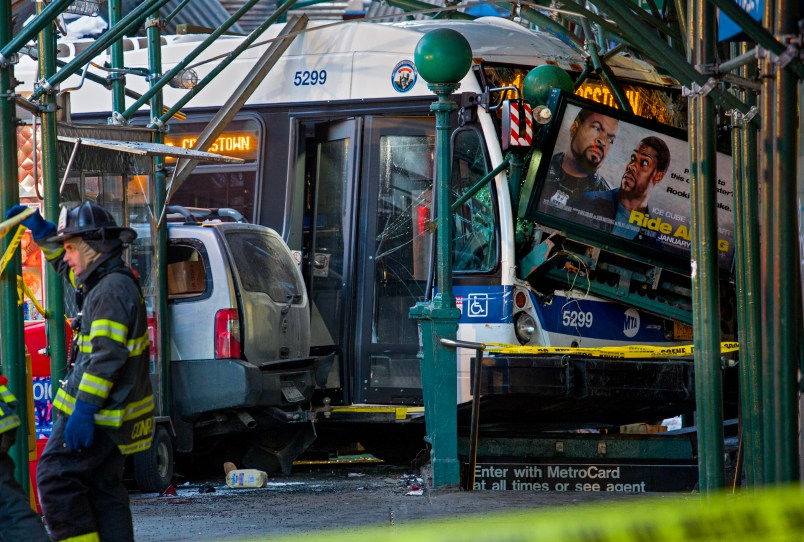About 5:30 this morning NYPD patrol cars were engaged in a high speed chase of a stolen truck in Greenwich Village when the truck collided with an MTA commuter bus. Both vehicles then careened up onto a sidewalk and plowed into building scaffolding where both vehicles came to a stop. William Pena, who had been driving city buses since 1996, was pronounced dead on the scene. Three passengers were taken to a local hospital. The driver of the truck suffered minor neck injuries and was taken into custody.
This incident particularly caught my attention because it happened at the intersection of 14th Street and 7th Avenue which is on bus route that I sometimes use to take my two sons to school. But I’m writing about it because I’ve always questioned the procedures police use when engaged in chases in heavily populated urban areas.
Back sometime around the time William Pena starting driving MTA buses, I was living in Providence, Rhode Island, studying for my Phd. And one afternoon I was walking across a small residential street between Wickenden Street and India Point when a car followed by three police cars raced past me going probably 40 to 50 miles an hour. I threw myself against a parked car and missed being run over by perhaps a two feet at the most.
We’ve all had a few close calls in our lives and it rivets you for a while with the fortuitous nature of our existence and how the threat of our random demise hangs randomly at all times somewhere in the distance. But as I was collecting myself I noticed that the chase was continuing in this tiny warren of streets that was actually totally bounded on all sides. In other words, probably half a dozen police cars were racing around through this tiny area, side-swiping various cars, banging into this and that, nearly running over people, doing various damage here and there in this one area that could easily be blocked off at three or four access points and then the whole thing would be over.

As you can see here, I’m talking about the area bounded by Wickenden and Traverse streets. It’s about as enclosed an area as you can get. And, by the way, that body of water is a tributary of the Atlantic Ocean. So again, why is this high speed chase happening? (If memory serves the whole drama ended when the chasee slammed into another civilian car, apparently without major injuries.)
I tend to have a pretty high regard for the importance of my own personal safety. So my moment of terror channeled itself into a righteous indignation of WTF and when I got home (not a lot of cell phones in those days) I called the police to complain. I got piped through to a gruff middle aged cop who listens for a moment and then cuts me off with his deep old school Providence accent, “Ohhhhhh, so you wanna complain about this? I got dat right?”
So that was the end of my of my anti-high-speed chase activism.
But the point has always staid with me. Police needlessly endanger people and cause the destruction of property by chasing people in situations where the risks of the chase clearly outweigh the public safety benefit of capture. Or in still other cases, the chase goes on when it would be very simple to park cars in front of a few access points and trap the person.
Now to be clear, if you’re chasing an armed robber or a murderer or someone else who poses a clear and present danger to public safety, that’s a different situation. (In the case in Providence, the chase started with an attempted speeding stop on the highway.) It’s also true that once a chase gets started, which is obviously dangerous for the police too, it’s probably asking too much of human nature to have a few a half a dozen cops speeding 70 miles an hour in different directions get on the car radio and say,”Guys, let’s step for a moment and consider whether this chase makes sense by a clear-eyed cost benefit analysis.”
But that’s precisely why organizations have procedures in place – to kick in in certain situations where adrenaline and uncertainty make that kind of bigger picture too hard to see.
This incident with the bus this morning made me think of this earlier situation because that part of lower Manhattan is a very strict grid, though things get a bit squirrelier a bit to the south in Greenwich Village proper. There are only so many places to go. It’s not as ridiculous as my case back in Providence where the perp was basically already trapped but no one seemed to realize it. But still.
Again, I see the complexity. You can’t just have a policy of letting people go once they gun the engine. It’s hard to know where things will lead when a chase starts. And you don’t know at the outset what’s making the person run – something that in itself legitimately raises suspicion that the person’s up to no good. Finally, even the sort of blockading is probably easier eye-balled than executed in practice.
But for all that, in many cases, there’s got to be a better way to do this.






